Chinese dragon
A Chinese dragon, also known as Long or Lung, is a legendary creature in Chinese mythology, Chinese folklore, and Chinese culture at large. Chinese dragons have many animal-like forms such as turtles and fish, but are most commonly depicted as snake-like with four legs. They traditionally symbolize potent and auspicious powers, particularly control over water, rainfall, typhoons, and floods. The dragon is also a symbol of power, strength, and good luck for people who are worthy of it in East Asian culture. During the days of Imperial China, the Emperor of China usually used the dragon as a symbol of his imperial strength and power.[1] In Chinese culture, excellent and outstanding people are compared to a dragon, while incapable people with no achievements are compared to other, disesteemed creatures, such as a worm. A number of Chinese proverbs and idioms feature references to a dragon, such as "Hoping one's child will become a dragon" (simplified Chinese: 望子成龙; traditional Chinese: 望子成龍; pinyin: wàng zǐ chéng lóng).


| Chinese dragon | |||||||||||||||||||||||||||||||||||||||
|---|---|---|---|---|---|---|---|---|---|---|---|---|---|---|---|---|---|---|---|---|---|---|---|---|---|---|---|---|---|---|---|---|---|---|---|---|---|---|---|
.svg.png.webp) "Dragon" in oracle bone script (top left), bronze script (top right), seal script (middle left), Traditional (middle right), Japanese new-style (shinjitai, bottom left), and Simplified (bottom right) Chinese characters | |||||||||||||||||||||||||||||||||||||||
| Traditional Chinese | 龍 | ||||||||||||||||||||||||||||||||||||||
| Simplified Chinese | 龙 | ||||||||||||||||||||||||||||||||||||||
| |||||||||||||||||||||||||||||||||||||||
Affiliated Chinese surnames include 龐 / 庞 (Dragon God, House of Dragon) and 龍 / 龙 (Dragon).
Symbolic value

Historically, the Chinese dragon was associated with the Emperor of China and used as a symbol to represent imperial power. The founder of the Han dynasty Liu Bang claimed that he was conceived after his mother dreamt of a dragon.[3] During the Tang dynasty, Emperors wore robes with dragon motif as an imperial symbol, and high officials might also be presented with dragon robes.[4] In the Yuan dynasty, the two-horned five-clawed dragon was designated for use by the Son of Heaven or Emperor only, while the four-clawed dragon was used by the princes and nobles.[5] Similarly during the Ming and Qing dynasty, the five-clawed dragon was strictly reserved for use by the Emperor only. The dragon in the Qing dynasty appeared on the first Chinese national flag.[6]
The dragon is sometimes used in the West as a national emblem of China though such use is not commonly seen in the People's Republic of China or the Republic of China. Instead, it is generally used as the symbol of culture. In Hong Kong, the dragon was a component of the coat of arms under British rule. It was later to become a feature of the design of Brand Hong Kong, a government promotional symbol.[7]
The Chinese dragon has very different connotations from the European dragon – in European cultures, the dragon is a fire-breathing creature with aggressive connotations, whereas the Chinese dragon is a spiritual and cultural symbol that represents prosperity and good luck, as well as a rain deity that fosters harmony. It was reported that the Chinese government decided against using the dragon as its official 2008 Summer Olympics mascot because of the aggressive connotations that dragons have outside of China, and chose more "friendly" symbols instead.[8] Sometimes Chinese people use the term "Descendants of the Dragon" (simplified Chinese: 龙的传人; traditional Chinese: 龍的傳人) as a sign of ethnic identity, as part of a trend started in the 1970s when different Asian nationalities were looking for animal symbols as representations, for example, the wolf may be used by the Mongols as it is considered to be their legendary ancestor.[3][6][9]
State symbol
The dragon was the symbol of the Chinese emperor for many dynasties. During the Qing dynasty, the Azure Dragon was featured on the first Chinese national flag. It was featured again on the Twelve Symbols national emblem, which was used during the Republic of China, from 1913 to 1928.
.svg.png.webp) Flag of the Qing dynasty, 1889–1912
Flag of the Qing dynasty, 1889–1912.svg.png.webp) Flag of the Chinese Eastern Railway, 1897–1915
Flag of the Chinese Eastern Railway, 1897–1915.svg.png.webp) Flag of the Commissioner of Weihaiwei with the Chinese dragon in the center, 1899–1903
Flag of the Commissioner of Weihaiwei with the Chinese dragon in the center, 1899–1903 State emblem of Republic of China, 1913–1928
State emblem of Republic of China, 1913–1928.svg.png.webp) Chinese dragon was one of the supporters of the colonial arms of Hong Kong until 1997
Chinese dragon was one of the supporters of the colonial arms of Hong Kong until 1997.svg.png.webp) Chinese dragon was holding a shield from the arms of Portugal in the colonial arms of the Government of Macau until 1999
Chinese dragon was holding a shield from the arms of Portugal in the colonial arms of the Government of Macau until 1999
Dragon worship

Origin
The ancient Chinese self-identified as "the gods of the dragon" because the Chinese dragon is an imagined reptile that represents evolution from the ancestors and qi energy.[10] The presence of dragons within Chinese culture dates back several thousands of years with the discovery of a dragon statue dating back to the fifth millennium BC from the Yangshao culture in Henan in 1987,[11] and jade badges of rank in coiled form have been excavated from the Hongshan culture circa 4700–2900 BC.[12] Some of the earliest Dragon artifacts are the pig dragon carvings from the Hongshan culture.
The coiled dragon or snake form played an important role in early Chinese culture. The character for "dragon" in the earliest Chinese writing has a similar coiled form, as do later jade dragon amulets from the Shang period.[13]
Ancient Chinese referred to unearthed dinosaur bones as dragon bones and documented them as such. For example, Chang Qu in 300 BC documents the discovery of "dragon bones" in Sichuan.[14] The modern Chinese term for dinosaur is written as 恐龍; 恐龙; kǒnglóng ('terror dragon'), and villagers in central China have long unearthed fossilized "dragon bones" for use in traditional medicines, a practice that continues today.[15]
The binomial name for a variety of dinosaurs discovered in China, Mei long, in Chinese (寐 mèi and 龙 lóng) means 'sleeping dragon'. Fossilized remains of Mei long have been found in China in a sleeping and coiled form, with the dinosaur nestling its snout beneath one of its forelimbs while encircling its tail around its entire body.[16]
Mythical creature

From its origins as totems or the stylized depiction of natural creatures, the Chinese dragon evolved to become a mythical animal. The Han dynasty scholar Wang Fu recorded Chinese myths that long dragons had nine anatomical resemblances.
The people paint the dragon's shape with a horse's head and a snake's tail. Further, there are expressions as 'three joints' and 'nine resemblances' (of the dragon), to wit: from head to shoulder, from shoulder to breast, from breast to tail. These are the joints; as to the nine resemblances, they are the following: his antlers resemble those of a stag, his head that of a camel, his eyes those of a demon, his neck that of a snake, his belly that of a clam (shen, 蜃), his scales those of a carp, his claws those of an eagle, his soles those of a tiger, his ears those of a cow. Upon his head he has a thing like a broad eminence (a big lump), called [chimu] (尺木). If a dragon has no [chimu], he cannot ascend to the sky.[17]
Further sources give variant lists of the nine animal resemblances. Sinologist Henri Doré lists these characteristics of an authentic dragon: "The antlers of a deer. The head of a crocodile. A demon's eyes. The neck of a snake. A tortoise's viscera. A hawk's claws. The palms of a tiger. A cow's ears. And it hears through its horns, its ears being deprived of all power of hearing."[18] He notes that, "Others state it has a rabbit's eyes, a frog's belly, a carp's scales." The anatomy of other legendary creatures, including the chimera and manticore, is similarly amalgamated from fierce animals.
Chinese dragons were considered to be physically concise. Of the 117 scales, 81 are of the yang essence (positive) while 36 are of the yin essence (negative). Initially, the dragon was benevolent, wise, and just, but the Buddhists introduced the concept of malevolent influence among some dragons. Just as water destroys, they said, so can some dragons destroy via floods, tidal waves, and storms. They suggested that some of the worst floods were believed to have been the result of a mortal upsetting a dragon.
Many pictures of Chinese dragons show a flaming pearl under their chin or in their claws. The pearl is associated with spiritual energy, wisdom, prosperity, power, immortality, thunder, or the moon. Chinese art often depicts a pair of dragons chasing or fighting over the flaming pearl.
Chinese dragons are occasionally depicted with bat-like wings growing out of the front limbs, but most do not have wings, as their ability to fly (and control rain/water, etc.) is mystical and not seen as a result of their physical attributes.
This description accords with the artistic depictions of the dragon down to the present day. The dragon has also acquired an almost unlimited range of supernatural powers. It is said to be able to disguise itself as a silkworm, or become as large as our entire universe. It can fly among the clouds or hide in water (according to the Guanzi). It can form clouds, can turn into water, can change color as an ability to blend in with their surroundings, as an effective form of camouflage or glow in the dark (according to the Shuowen Jiezi).
In many other countries, folktales speak of the dragon having all the attributes of the other 11 creatures of the zodiac, this includes the whiskers of the Rat, the face and horns of the Ox, the claws and teeth of the Tiger, the belly of the Rabbit, the body of the Snake, the legs of the Horse, the goatee of the Goat, the wit of the Monkey, the crest of the Rooster, the ears of the Dog, and the snout of the Pig.
In some circles, it is considered bad luck to depict a dragon facing downwards, as it is seen as disrespectful to place a dragon in such manner that it cannot ascend to the sky. Also, depictions of dragons in tattoos are prevalent as they are symbols of strength and power, especially criminal organisations where dragons hold a meaning all on their own. As such, it is believed that one must be fierce and strong enough, hence earning the right to wear the dragon on his skin, lest his luck be consumed by the dragons.
According to an art historian John Boardman, depictions of Chinese Dragon and Indian Makara might have been influenced by Kētos in Greek Mythology possibly after contact with silk-road images of the Kētos as Chinese dragon appeared more reptilian and shifted head-shape afterwards.[19]
Ruler of weather and water

Chinese dragons are strongly associated with water and weather in popular religion. They are believed to be the rulers of moving bodies of water, such as waterfalls, rivers, or seas. The Dragon God is the dispenser of rain as well as the zoomorphic representation of the yang masculine power of generation.[20] In this capacity as the rulers of water and weather, the dragon is more anthropomorphic in form, often depicted as a humanoid, dressed in a king's costume, but with a dragon head wearing a king's headdress.
There are four major Dragon Kings, representing each of the Four Seas: the East Sea (corresponding to the East China Sea), the South Sea (corresponding to the South China Sea), the West Sea (sometimes seen as the Qinghai Lake and beyond), and the North Sea (sometimes seen as Lake Baikal).
Because of this association, they are seen as "in charge" of water-related weather phenomena. In premodern times, many Chinese villages (especially those close to rivers and seas) had temples dedicated to their local "dragon king". In times of drought or flooding, it was customary for the local gentry and government officials to lead the community in offering sacrifices and conducting other religious rites to appease the dragon, either to ask for rain or a cessation thereof.
The King of Wuyue in the Five Dynasties and Ten Kingdoms period was often known as the "Dragon King" or the "Sea Dragon King" because of his extensive hydro-engineering schemes which "tamed" the sea.
Symbol of imperial authority

According to Chinese legend, both Chinese primogenitors, the earliest Door and the Yellow Emperor (Huangdi), were closely related to 'Long' (Chinese dragon). At the end of his reign, the first legendary ruler, the Yellow Emperor, was said to have been immortalized into a dragon that resembled his emblem, and ascended to Heaven. The other legendary ruler, the Yan Emperor, was born by his mother's telepathy with a mythical dragon. Since the Chinese consider the Yellow Emperor and the Yan Emperor as their ancestors, they sometimes refer to themselves as "the descendants of the dragon". This legend also contributed towards the use of the Chinese dragon as a symbol of imperial power.
Dragons (usually with five claws on each foot) were a symbol for the emperor in many Chinese dynasties. During the Qing dynasty, the imperial dragon was colored yellow or gold, and during the Ming dynasty it was red.[21] The imperial throne was referred to as the Dragon Throne. During the late Qing dynasty, the dragon was even adopted as the national flag. Dragons are featured in carvings on the stairs and walkways of imperial palaces and imperial tombs, such as at the Forbidden City in Beijing.
In some Chinese legends, an emperor might be born with a birthmark in the shape of a dragon. For example, one legend tells the tale of a peasant born with a dragon birthmark who eventually overthrows the existing dynasty and founds a new one; another legend might tell of the prince in hiding from his enemies who is identified by his dragon birthmark.
In contrast, the Empress of China was often identified with the Chinese phoenix.
Modern belief
Worship of the Dragon God is celebrated throughout China with sacrifices and processions during the fifth and sixth moons, and especially on the date of his birthday the thirteenth day of the sixth moon.[20] A folk religious movement of associations of good-doing in modern Hebei is primarily devoted to a generic Dragon God whose icon is a tablet with his name inscribed, for which it has been named the "movement of the Dragon Tablet".[22]
Depictions of the dragon


Neolithic depictions
Dragons or dragon-like depictions have been found extensively in neolithic-period archaeological sites throughout China. Some of earliest depictions of dragons were found at Xinglongwa culture sites. Yangshao culture sites in Xi'an have produced clay pots with dragon motifs. A burial site Xishuipo in Puyang which is associated with the Yangshao culture shows a large dragon mosaic made out of clam shells.[23] The Liangzhu culture also produced dragon-like patterns. The Hongshan culture sites in present-day Inner Mongolia produced jade dragon objects in the form of pig dragons which are the first 3-dimensional representations of Chinese dragons.[24]
One such early form was the pig dragon. It is a coiled, elongated creature with a head resembling a boar.[25] The character for "dragon" in the earliest Chinese writing has a similar coiled form, as do later jade dragon amulets from the Shang dynasty.
Classical depictions
Chinese literature and myths refer to many dragons besides the famous long. The linguist Michael Carr analyzed over 100 ancient dragon names attested in Chinese classic texts.[26] Many such Chinese names derive from the suffix -long:
- Tianlong (Chinese: 天龍; pinyin: tiānlóng; Wade–Giles: t'ien-lung; lit. 'heavenly dragon'), celestial dragon that guards heavenly palaces and pulls divine chariots; also a name for the constellation Draco
- Shenlong (神龍; shénlóng; shen-lung; 'god dragon'), thunder god that controls the weather, appearance of a human head, dragon's body, and drum-like stomach
- Fuzanglong (伏藏龍; fúcánglóng; fu-ts'ang-lung; 'hidden treasure dragon'), underworld guardian of precious metals and jewels, associated with volcanoes
- Dilong (地龍; dìlóng; ti-lung; 'earth dragon'), controller of rivers and seas; also a name for earthworm
- Yinglong (應龍; yìnglóng; ying-lung; 'responding dragon'), winged dragon associated with rains and floods, used by Yellow Emperor to kill Chi You
- Jiaolong (蛟龍; jiāolóng; chiao-lung; 'crocodile dragon'), hornless or scaled dragon, leader of all aquatic animals
- Panlong (蟠龍; pánlóng; p'an-lung; 'coiled dragon'), lake dragon that has not ascended to heaven
- Huanglong (黃龍; huánglóng; huang-lung; 'yellow dragon'), hornless dragon symbolizing the emperor
- Feilong (飛龍; fēilóng; fei-lung; 'flying dragon'), winged dragon that rides on clouds and mist; also a name for a genus of pterosaur (compare Feilong kick and Fei Long character)
- Qinglong (青龍; qīnglóng; ch'ing-lung; 'Azure Dragon'), the animal associated with the East in the Chinese Four Symbols, mythological creatures in the Chinese constellations
- Qiulong (虯龍; qíulóng; ch'iu-lung; 'curling dragon'), contradictorily defined as both "horned dragon" and "hornless dragon"
- Zhulong (燭龍; zhúlóng; chu-lung; 'torch dragon') or Zhuyin (燭陰; zhúyīn; chu-yin; 'illuminating darkness') was a giant red draconic solar deity in Chinese mythology. It supposedly had a human's face and snake's body, created day and night by opening and closing its eyes, and created seasonal winds by breathing. (Note that this zhulong is different from the similarly named Vermilion Dragon or the Pig dragon).
- Chilong (螭龍 or 魑龍; chīlóng; ch'ih-lung; 'demon dragon'), a hornless dragon or mountain demon
Fewer Chinese dragon names derive from the prefix long-:
- Longwang (龍王; lóngwáng; lung-wang; 'Dragon Kings') divine rulers of the Four Seas
- Longma (龍馬; lóngmǎ; lung-ma; 'dragon horse'), emerged from the Luo River and revealed ba gua to Fu Xi
Some additional Chinese dragons are not named with long 龍, for instance,
- Hong (虹; hóng; hung; 'rainbow'), a two-headed dragon or rainbow serpent
- Shen (蜃; shèn; shen; 'giant clam'), a shapeshifting dragon or sea monster believed to create mirages
- Bashe (巴蛇; bāshé; pa-she; 'ba snake') was a giant python-like dragon that ate elephants
- Teng (螣; téng; t'eng) or Tengshe (腾蛇; 騰蛇; téngshé; t'eng-she; lit. "soaring snake") is a flying dragon without legs
Chinese scholars have classified dragons in diverse systems. For instance, Emperor Huizong of the Song dynasty canonized five colored dragons as "kings".
- The Azure Dragon [Qinglong 青龍] spirits, most compassionate kings.
- The Vermilion Dragon [Zhulong 朱龍 or Chilong 赤龍] spirits, kings that bestow blessings on lakes.
- The Yellow Dragon [Huanglong 黃龍] spirits, kings that favorably hear all petitions.
- The White Dragon [Bailong 白龍] spirits, virtuous and pure kings.
- The Black Dragon [Xuanlong 玄龍 or Heilong 黑龍] spirits, kings dwelling in the depths of the mystic waters.[27]
With the addition of the Yellow Dragon of the Center to Azure Dragon of the East, these Vermilion, White, and Black Dragons coordinate with the Four Symbols, including the Vermilion Bird of the South, White Tiger of the West, and Black Tortoise of the North.
Nine sons of the dragon

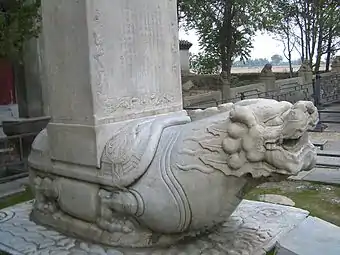
Several Ming dynasty texts list what were claimed as the Nine Offspring of the Dragon (龍生九子), and subsequently these feature prominently in popular Chinese stories and writings. The scholar Xie Zhaozhe (1567–1624) in his work Wu Za Zu Wuzazu (c. 1592) gives the following listing, as rendered by M.W. de Visser:
A well-known work of the end of the sixteenth century, the Wuzazu 五雜俎, informs us about the nine different young of the dragon, whose shapes are used as ornaments according to their nature.
- The [pú láo 蒲牢], four leg small form dragon class which like to scream, are represented on the tops of bells, serving as handles.
- The [qiú niú 囚牛], which like music, are used to adorn musical instruments.
- The [chī wěn 蚩吻], which like swallowing, are placed on both ends of the ridgepoles of roofs (to swallow all evil influences).
- The [cháo fēng 嘲風], beasts-like dragon which like adventure, are placed on the four corners of roofs.
- The [yá zì 睚眦], which like to kill, are engraved on sword guards.
- The [xì xì 屓屭], which have the shape of the [chī hǔ 螭虎 (One kind small form dragon)], and are fond of literature, are represented on the sides of grave-monuments.
- The [bì àn 狴犴], which like litigation, are placed over prison gates (in order to keep guard).
- The [suān ní 狻猊], which like to sit down, are represented upon the bases of Buddhist idols (under the Buddhas' or Bodhisattvas' feet).
- The [bì xì 贔屭], also known as [bà xià 霸下], finally, big tortoises which like to carry heavy objects, are placed under grave-monuments.
Further, the same author enumerates nine other kinds of dragons, which are represented as ornaments of different objects or buildings according to their liking prisons, water, the rank smell of newly caught fish or newly killed meat, wind and rain, ornaments, smoke, shutting the mouth (used for adorning key-holes), standing on steep places (placed on roofs), and fire.[28]
The Sheng'an waiji (升庵外集) collection by the poet Yang Shen (楊慎, 1488–1559) gives different 5th and 9th names for the dragon's nine children: the tāo tiè (饕餮), form of beasts, which loves to eat and is found on food-related wares, and the jiāo tú (椒圖), which looks like a conch or clam, does not like to be disturbed, and is used on the front door or the doorstep. Yang's list is bì xì, chī wěn or cháo fēng, pú láo, bì àn, tāo tiè, qiú niú, yá zì, suān ní, and jiāo tú. In addition, there are some sayings including [bā xià 𧈢𧏡], Hybrid of reptilia animal and dragon, a creature that likes to drink water, and is typically used on bridge structures.[29]
The oldest known attestation of the "children of the dragon" list is found in the Shuyuan zaji (菽園雜記, Miscellaneous records from the bean garden) by Lu Rong (1436–1494); however, he noted that the list enumerates mere synonyms of various antiques, not children of a dragon.[30] The nine sons of the dragon were commemorated by the Shanghai Mint in 2012's year of the dragon with two sets of coins, one in silver, and one in brass. Each coin in the sets depicts one of the 9 sons, including an additional coin for the father dragon, which depicts the nine sons on the reverse.[31] It's also a Chinese idiom, which means among brothers each one has his good points.
Dragon claws
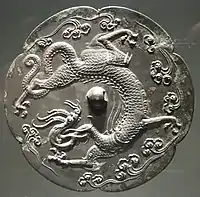
Early Chinese dragons are depicted with two to five claws. Different countries that adopted the Chinese dragon have different preferences; in Mongolia and Korea, four-clawed dragons are used, while in Japan, three-clawed dragons are common.[32] In China, three-clawed dragons were popularly used on robes during the Tang dynasty.[33] The usage of the dragon motif was codified during the Yuan dynasty, and the five-clawed dragons became reserved for use by the emperor while the princes used four-clawed dragons.[5] Phoenixes and five-clawed two-horned dragons may not be used on the robes of officials and other objects such as plates and vessels in the Yuan dynasty.[5][34] It was further stipulated that for commoners, "it is forbidden to wear any cloth with patterns of Qilin, Male Fenghuang (Chinese phoenix), White rabbit, Lingzhi, Five-Toe Two-Horn Dragon, Eight Dragons, Nine Dragons, 'Ten thousand years', Fortune-longevity character and Golden Yellow etc."[35]
The Hongwu Emperor of the Ming dynasty emulated the Yuan dynasty rules on the use of the dragon motif and decreed that the dragon would be his emblem and that it should have five claws. The four-clawed dragon would be used typically for imperial nobility and certain high-ranking officials. The three-clawed dragon was used by lower ranks and the general public (widely seen on various Chinese goods in the Ming dynasty). The dragon, however, was only for select royalty closely associated with the imperial family, usually in various symbolic colors, while it was a capital offense for anyone—other than the emperor himself—to ever use the completely gold-colored, five-clawed Long dragon motif. Improper use of claw number or colors was considered treason, punishable by execution of the offender's entire clan. During the Qing dynasty, the Manchus initially considered three-clawed dragons the most sacred and used that until 1712 when it was replaced by five-clawed dragons, and portraits of the Qing emperors were usually depicted with five-clawed dragons.[36]
In works of art that left the imperial collection, either as gifts or through pilfering by court eunuchs (a long-standing problem), where practicable, one claw was removed from each set, as in several pieces of carved lacquerware,[37] for example the well known Chinese lacquerware table in the Victoria and Albert Museum in London.[38]
Cultural references
Number nine
The number nine is special in China as it is seen as number of the heaven, and Chinese dragons are frequently connected with it. For example, a Chinese dragon is normally described in terms of nine attributes and usually has 117 (9×13) scales–81 (9×9) Yang and 36 (9×4) Yin. This is also why there are nine forms of the dragon and there are 9 sons of the dragon (see Classical depictions above). The Nine-Dragon Wall is a spirit wall with images of nine different dragons, and is found in imperial Chinese palaces and gardens. Because nine was considered the number of the emperor, only the most senior officials were allowed to wear nine dragons on their robes—and then only with the robe completely covered with surcoats. Lower-ranking officials had eight or five dragons on their robes, again covered with surcoats; even the emperor himself wore his dragon robe with one of its nine dragons hidden from view.
There are a number of places in China called "Nine Dragons", the most famous being Kowloon (in Cantonese) in Hong Kong. The part of the Mekong in Vietnam is known as Cửu Long, with the same meaning.
Chinese zodiac
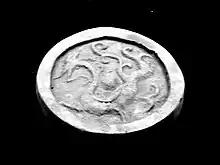
The Dragon is one of the 12 animals in the Chinese zodiac which is used to designate years in the Chinese calendar. It is thought that each animal is associated with certain personality traits. Dragon years are usually the most popular to have children. There are more people born in Dragon years than in any other animal years of the zodiac.[39]
Constellations
The Azure Dragon (Qing Long, 青龍) is considered to be the primary of the four celestial guardians, the other three being the Zhu Que—朱雀 (Vermilion Bird), Bai Hu—白虎 (White Tiger), Xuan Wu—玄武 (Black Tortoise-like creature). In this context, the Azure Dragon is associated with the East and the element of Wood.
Dragonboat racing

|thumb|220px|Dragon boats racing in Hong Kong]] At special festivals, especially the Duanwu Festival, dragon boat races are an important part of festivities. Typically, these are boats paddled by a team of up to 20 paddlers with a drummer and steersman. The boats have a carved dragon as the head and tail of the boat. Dragon boat racing is also an important part of celebrations outside of China, such as at Chinese New Year. A similar racing is popular in India in the state of Kerala called Vallamkali and there are records on Chinese traders visiting the seashores of Kerala centuries back (Ibn Batuta).
Dragon dancing
On auspicious occasions, including Chinese New Year and the opening of shops and residences, festivities often include dancing with dragon puppets. These are "life sized" cloth-and-wood puppets manipulated by a team of people, supporting the dragon with poles. They perform choreographed moves to the accompaniment of drums, drama, and music. They also wore good clothing made of silk.
Dragon and Fenghuang
Fenghuang (simplified Chinese: 凤凰; traditional Chinese: 鳳凰; pinyin: fènghuáng; Wade–Giles: fêng4-huang2), known in Japanese as Hō-ō or Hou-ou, are phoenix-like birds found in East Asian mythology that reign over all other birds. In Chinese symbolism, it is a feminine entity that is paired with the masculine Chinese dragon, as a visual metaphor of a balanced and blissful relationship, symbolic of both a happy marriage and a regent's long reign.
Dragon as nāga

In many Buddhist countries, the concept of the nāga has been merged with local traditions of great and wise serpents or dragons, as depicted in this stairway image of a multi-headed nāga emerging from the mouth of a Makara in the style of a Chinese dragon at Phra Maha Chedi Chai Mongkol on the premises of Wat Pha Namthip Thep Prasit Vararam in Thailand's Roi Et Province Nong Phok District.
Dragons and tigers
The tiger is considered to be the eternal rival to the dragon, thus various artworks depict a dragon and tiger fighting an epic battle. A well used Chinese idiom to describe equal rivals (often in sports nowadays) is "Dragon versus Tiger". In Chinese martial arts, "Dragon style" is used to describe styles of fighting based more on understanding movement, while "Tiger style" is based on brute strength and memorization of techniques.
Dragons and botany

The elm cultivar Ulmus pumila 'Pendula', from northern China, called 'Weeping Chinese Elm' in the West, is known locally as Lung chao yü shu (: 'Dragon's-claw elm') owing to its branching.[40][41]
In popular culture
- As a part of traditional folklore, dragons appear in a variety of mythological fiction. In the classical novel Journey to the West, the son of the Dragon King of the West was condemned to serve as a horse for the travelers because of his indiscretions at a party in the heavenly court. Sun Wukong's staff, the Ruyi Jingu Bang, was robbed from Ao Guang, the Dragon King of the East Sea. In Fengshen Yanyi and other stories, Nezha, the boy hero, defeats the Dragon Kings and tames the seas. Chinese dragons also appear in innumerable Japanese anime films and television shows, manga, and in Western political cartoons as a personification of the People's Republic of China. The Chinese respect for dragons is emphasized in Naomi Novik's Temeraire novels, where they were the first people to tame dragons and are treated as equals, intellectuals, or even royalty, rather than beasts solely bred for war in the West. Manda is a large Chinese dragon that appears in the Godzilla storyline. A golden three-headed dragon also appears in the comic book series God Is Dead.
- Red dragon is a symbol of China which appears in many Mahjong games.
- A Chinese Water-Dragon is used as the main antagonist in Season 3 of the Australian television series Mako Mermaids. The Dragon is heavily based on Chinese mythology to coincide with a new Chinese mermaid on the show.
- The main antagonist of Wendy Wu: Homecoming Warrior, Yan-Lo, was a Chinese dragon. Despite the fact that he's deceased during the events of the film, he continues to hatch evil plans in the form of a spirit.
- In Monster High, Jinafire Long is the daughter of a Chinese dragon.
Regional variations across East, South and Southeast Asia

While depictions of the dragon in art and literature are consistent throughout the cultures in which it is found, there are some regional differences.
For more information on peculiarities in the depiction of the dragon in East Asian, South Asian, and Southeast Asian cultures, see:
Dragons related to the Chinese dragon:
- Druk, the Thunder Dragon of Bhutanese mythology
- Japanese dragon
- Korean dragon
- Nāga, a Hindu and Buddhist creature in South Asian and Southeast Asian mythology.
- Bakunawa, a moon-eating sea dragon depicted in Philippine mythology.
- Pakhangba, a Manipuri dragon.
- Vietnamese dragon
Dragons similar to the Chinese dragon:
Architecture gallery

 Nine Dragon Wall, Datong, Ming dynasty
Nine Dragon Wall, Datong, Ming dynasty Nine-Dragon Wall in Beihai Park, built in 1756
Nine-Dragon Wall in Beihai Park, built in 1756 Dragon column remains, Jin dynasty (1115–1234)
Dragon column remains, Jin dynasty (1115–1234)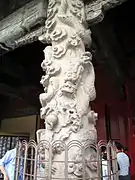 Column with dragon design at Temple of Confucius, Qufu, constructed in 1730, Qing dynasty
Column with dragon design at Temple of Confucius, Qufu, constructed in 1730, Qing dynasty Dragon columns at the Temple of Confucius, Qufu
Dragon columns at the Temple of Confucius, Qufu Stone relief of dragons between a flight of stairs in the Forbidden City
Stone relief of dragons between a flight of stairs in the Forbidden City
Textile gallery
 Emperor Taizong of Tang in dragon robes
Emperor Taizong of Tang in dragon robes Dragon images on the borders of Empress Yang's robes, Song dynasty
Dragon images on the borders of Empress Yang's robes, Song dynasty The Hongwu Emperor in a dragon robe, Ming dynasty
The Hongwu Emperor in a dragon robe, Ming dynasty The Qianlong Emperor in ceremonial armor decorated with numerous images of dragons, Qing dynasty
The Qianlong Emperor in ceremonial armor decorated with numerous images of dragons, Qing dynasty_and_Horse_MET_DP277203.jpg.webp) Ceremonial Qing dynasty armour with dragon imagery, 18th c.
Ceremonial Qing dynasty armour with dragon imagery, 18th c. Court robe with nine dragons, Qing dynasty
Court robe with nine dragons, Qing dynasty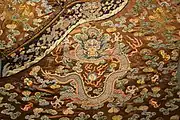 Dragon in the center of a court robe, Qing dynasty
Dragon in the center of a court robe, Qing dynasty
Painting gallery
 Man riding a dragon, Warring States period
Man riding a dragon, Warring States period Azure Dragon of the East, Han dynasty
Azure Dragon of the East, Han dynasty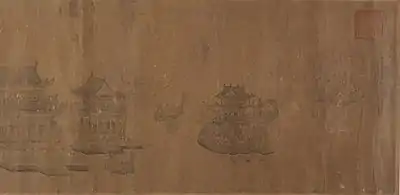 Boats with dragon heads, Yuan dynasty, 14th century
Boats with dragon heads, Yuan dynasty, 14th century Cloud Dragon by Anonymous, Ming dynasty, 15th-16th century
Cloud Dragon by Anonymous, Ming dynasty, 15th-16th century Dragon clouds and waves, 16th-17th century
Dragon clouds and waves, 16th-17th century Rocket projectile with a dragon head, Ming dynasty
Rocket projectile with a dragon head, Ming dynasty Fire lance shield with dragon head imagery, Ming dynasty
Fire lance shield with dragon head imagery, Ming dynasty
Metalwork gallery
 Bronze chariot shaft in the shape of a dragon head, Warring States period
Bronze chariot shaft in the shape of a dragon head, Warring States period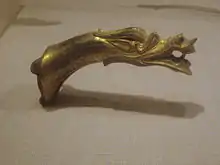 Bronze dragon head handle, Han dynasty
Bronze dragon head handle, Han dynasty_with_Dragon_LACMA_AC1998.251.32.jpg.webp) Lobed mirror, Tang dynasty
Lobed mirror, Tang dynasty Gilt gold dragon, Tang dynasty
Gilt gold dragon, Tang dynasty Dragon crown, Liao dynasty
Dragon crown, Liao dynasty Dragon and phoenix crowns, Liao dynasty
Dragon and phoenix crowns, Liao dynasty Gold cup with fish handles on a gilded silver dragon plate, Song dynasty
Gold cup with fish handles on a gilded silver dragon plate, Song dynasty
Jade gallery
 Jade cloud dragon, Warring States period
Jade cloud dragon, Warring States period Jade belt clasp, Northern and Southern dynasties period
Jade belt clasp, Northern and Southern dynasties period Jade belt plaque, Yuan dynasty
Jade belt plaque, Yuan dynasty Jade belt plaque, Ming dynasty
Jade belt plaque, Ming dynasty Jade belt plaque, Ming dynasty
Jade belt plaque, Ming dynasty Jade seal with dragon handle
Jade seal with dragon handle Jade vase
Jade vase
Ceramics
 Pot with black dragon design, Song dynasty
Pot with black dragon design, Song dynasty Dragon on blue and white vase from the Yuan dynasty (1271-1368), Jingdezhen, unearthed in Jiangxi Province.
Dragon on blue and white vase from the Yuan dynasty (1271-1368), Jingdezhen, unearthed in Jiangxi Province..JPG.webp) Lidded jar with yellow dragon, Ming dynasty
Lidded jar with yellow dragon, Ming dynasty Blue-and-white porcelain plate with a dragon, Ming dynasty
Blue-and-white porcelain plate with a dragon, Ming dynasty%252C_Zhengd_-_Bowl_with_Dragons_in_Waves_-_1989.290_-_Cleveland_Museum_of_Art.tif.jpg.webp) Green dragon on a bowl, Ming dynasty
Green dragon on a bowl, Ming dynasty Plate with two dragons, Qing dynasty
Plate with two dragons, Qing dynasty_with_Dragons_Chasing_Flaming_Pearl_LACMA_58.51.2a-b_(4_of_4).jpg.webp) Bowl with red dragon, Qing dynasty
Bowl with red dragon, Qing dynasty
Modern gallery
 Ziwei Chenheng, an armillary sphere with dragons holding it up
Ziwei Chenheng, an armillary sphere with dragons holding it up Non-Imperial Chinese dragon in Shanghai
Non-Imperial Chinese dragon in Shanghai Mini-Sculpture of a Dragon on top of a temple in Hsinchu, Taiwan
Mini-Sculpture of a Dragon on top of a temple in Hsinchu, Taiwan
 The Chinese dragon statue at Vihara Dharmayana Kuta, Bali
The Chinese dragon statue at Vihara Dharmayana Kuta, Bali
See also
- An Instinct for Dragons, hypothesis about the origin of dragon myths.
- Chinese mythology
- Fish in Chinese mythology
- Lei Chen-Tzu
- List of dragons in mythology and folklore
- List of dragons in popular culture
- Long Mu (Dragon's Mother)
- Radical 212
- Snakes in Chinese mythology, mostly about less dragon-like types
- China Dragon – hockey team playing in the Asia League Ice Hockey
References
Citations
- Ingersoll, Ernest; et al. (2013). The Illustrated Book of Dragons and Dragon Lore. Chiang Mai: Cognoscenti Books.
- "Chinese Dragon". The Walters Art Museum.
- Dikötter, Frank (10 November 1997). The Construction of Racial Identities in China and Japan. C Hurst & Co Publishers Ltd. pp. 76–77. ISBN 978-1850652878.
- "Imperial Dragons". Kyoto National Museum.
- Linda Komaroff, ed. (2006). Beyond the Legacy of Genghis Khan. Brill Academic Publishers. p. 320. ISBN 978-9047418573.
- Sleeboom, Margaret (2004). Academic Nations in China and Japan Framed in concepts of Nature, Culture and the Universal. Routledge publishing. ISBN 0-415-31545-X
- "Brand Overview", Brand Hong Kong, 09-2004 retrieved on 23-02-2007. Archived December 23, 2008, at the Wayback Machine
- "Fiery Debate Over China's Dragon", BBC News, an article covering China's decision not to use a dragon mascot and the resulting disappointment.
- "The Mongolian Message".
- Dr Zai, J. Taoism and Science: Cosmology, Evolution, Morality, Health and more. Ultravisum, 2015.
- Howard Giskin and Bettye S. Walsh (2001). An introduction to Chinese culture through the family. State University of New York Press. p. 126. ISBN 0-7914-5047-3.
- "Teaching Chinese Archeology" Archived 2008-02-11 at the Wayback Machine, National Gallery of Art, Washington, D.C.
- Salviati, Filippo (2002). The Language of Adornment: Chinese Ornaments of Jade, Crystal, Amber and Glass, Fig. 17. Ten Speed Press. ISBN 1-58008-587-3.
- Dong Zhiming (1992). Dinosaurian Faunas of China. China Ocean Press, Beijing. ISBN 3-540-52084-8. OCLC 26522845.
- "Dinosaur bones 'used as medicine'". BBC News Online. 2007-07-06. Retrieved 2007-07-06.
- Xu and Norell, (2004). "A new troodontid dinosaur from China with avian-like sleeping posture". Nature, 431(7010): 838–841. doi:10.1038/news041011-7
- de Visser, Marinus Willem (1913). "The Dragon in China and Japan". Verhandelingen der Koninklijke akademie van wetenschappen te Amsterdam. Afdeeling Letterkunde. Nieuwe reeks, deel xiii, no. 2. Amsterdam: Johannes Müller: 70. Cite journal requires
|journal=(help) (Also available at University of Georgia Library Archived 2016-12-25 at the Wayback Machine) - Doré, Henri (1966) [1917]. Researches into Chinese Superstitions. Translated by M. Kennelly; D. J. Finn; L. F. McGreat. Ch'eng-wen. p. 681.
- Boardman, John (2015). The Greeks in Asia. Thames and Hudson. ISBN 978-0500252130.
- Tom (1989), p. 55.
- Hayes, L. (1923). The Chinese Dragon. Shanghai, China: Commercial Press Ltd. Retrieved from https://archive.org/stream/chinesedragon00hayeuoft#page/n7/mode/2up
- Zhiya Hua. Dragon's Name: A Folk Religion in a Village in South-Central Hebei Province. Shanghai People's Publishing House, 2013. ISBN 7208113297
- Hung-Sying Jing; Allen Batteau (2016). The Dragon in the Cockpit: How Western Aviation Concepts Conflict with Chinese Value Systems. Routledge. p. 83. ISBN 978-1317035299.
- John Onians (26 April 2004). Atlas of World Art. Laurence King Publishing. p. 46. ISBN 978-1856693776.
- "Jade coiled dragon, Hongshan Culture (c. 4700–2920 B.C.)" Archived 2007-03-13 at the Wayback Machine, National Gallery of Art, Washington, D.C. Retrieved on 23-02-2007.
- Carr, Michael. 1990. "Chinese Dragon Names", Linguistics of the Tibeto-Burman Area 13.2:87–189. He classified them into seven categories: Rain-dragons, Flying-dragons, Snake-dragons, Wug-dragons [wug refers to "worms, bugs, and small reptiles"], Crocodile-dragons, Hill-dragons, and Miscellaneous dragons.
- Adapted from Doré 1966, p. 682.
- de Visser 1913, pp. 101–102. The primary source is Wu Za Zu, chapter 9, beginning with "龍生九子...". The title of Xie Zhaozhe's work, Wu Za Zu, has been variously translated into English as Five Assorted Offerings (in Xie Zhaozhe), Five Sundry Bands (in "Disease and Its Impact on Politics, Diplomacy, and the Military ...") or Five Miscellanies (in Changing clothes in China: fashion, history, nation, p. 48).
- 吾三省 (Wu Sanxing) (2006). 中國文化背景八千詞 (Eight thousand words and expressions viewed against the background of Chinese culture) (in Chinese). 商務印書館(香港) (Commercial Press, Hong Kong). p. 345. ISBN 962-07-1846-1.
- 九、龙的繁衍与附会 – 龙生九子 (1) ("Chapter 9, Dragon's derived and associated creatures: Nine children of the dragon (1)"), in Yang Jingrong and Liu Zhixiong (2008). The full text of Shuyuan zaji, from which Yang and Liu quote, is available in electronic format at a number of sites, e.g. here: 菽園雜記 Archived 2010-03-06 at the Wayback Machine
- CCT4243: 2012 lunar dragon nine sons of the dragon 20 coin set Archived 2016-03-04 at the Wayback Machine
- "Famous Japanese Dragons".
- Michael Sullivan (1992). The Arts of China. University of California Press. p. 214. ISBN 978-0520049185.
- 《志第二十八 輿服一》. The History of Yuan.
- 《本紀第三十九 順帝二》. The History of Yuan, Emperor Shundi (元史·順帝紀), compiled under Song Lian (宋濂), AD 1370.
禁服麒麟、鸞鳳、白兔、靈芝、雙角五爪龍、八龍、九龍、萬壽、福壽字、赭黃等服
- Roy Bates (2007). All About Chinese Dragons. p. 20–21. ISBN 978-1435703223.
- Rawson, Jessica (ed). The British Museum Book of Chinese Art, p. 177, 2007 (2nd edn), British Museum Press, ISBN 978-0714124469
- Clunas, Craig and Harrison-Hall, Jessica, Ming: 50 years that changed China, p. 107, 2014, British Museum Press, ISBN 978-0714124841
- Mocan & Yu, Naci H. & Han (May 2019) [August 2017]. "Can Superstition Create a Self-Fulfilling Prophecy? School Outcomes of Dragon Children of China" (PDF). The National Bureau of Economic Research (NBER Working Paper No. 23709): 13, 47. Retrieved 3 December 2019.
- U. pumila 'Pendula', 'Inventory of Seeds and Plants Imported ... April–June 1915' (March 1918), ars-grin.gov/npgs/pi_books/scans/pi043.pdf
- U. pumila 'Pendula', 中国自然标本馆. Cfh.ac.cn. Retrieved 2013-08-30.
Sources
- Nikaido, Yoshihiro (2015). Asian Folk Religion and Cultural Interaction. Vandenhoeck & Ruprecht. ISBN 978-3847004851.
- Overmyer, Daniel L. (2009). Local Religion in North China in the Twentieth Century: The Structure and Organization of Community Rituals and Beliefs. Brill. ISBN 978-9004175921.
- Tom, K. S. (1989). Echoes from Old China: Life, Legends, and Lore of the Middle Kingdom. University of Hawaii Press. ISBN 0824812859.
External links
| Wikimedia Commons has media related to: |
 Quotations related to Chinese dragon at Wikiquote
Quotations related to Chinese dragon at Wikiquote
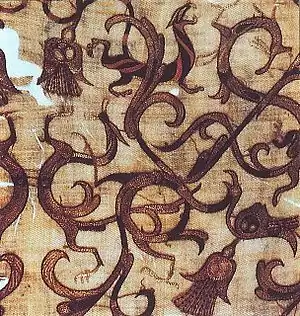


.svg.png.webp)